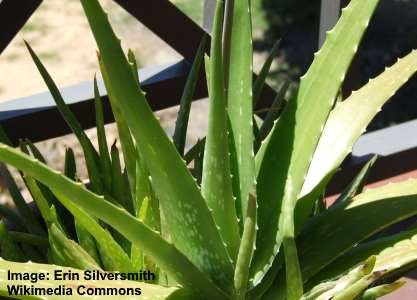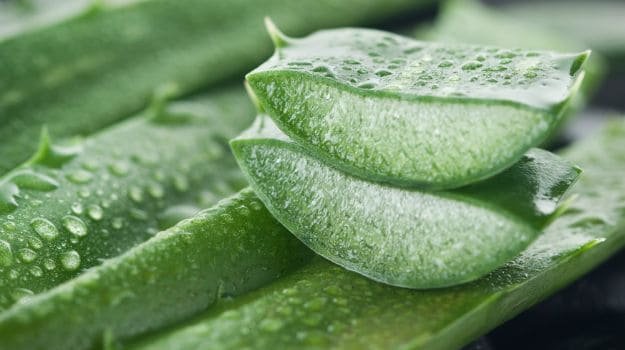"The
Aloe Vera Plant".

https://leafyplace.com/types-of-aloe-plants/

https://food.ndtv.com/beauty/6-amazing-benefits-aloe-vera-hair-skin-weight-loss-1221869
The Aloe Vera Plant
25.08.2020
It is an amazingly healthy and natural medicinal plant. This plant has been used as a medicinal plant for many years. This plant is a very healthy and well known plant for our human life. Ayurvedic medicine made from this plant relieves us from many diseases in human life.
Aloe vera is also scientifically known as this plant, also known as botanical name. This plant is deeply involved in botany. This plant has been discussed in various botanical books and even written in medical books about this plant. A few days ago I brought an M.Sc level botany book from the library to read.
There was a chapter in this book about this aloe vera plant and since this plant was known by name, I was very interested to know all about it. Then I open that chapter and try to read the details. While I was reading there I saw a lot of details written about this plant and I studied this plant for full 2 days.
Then after reading about all the topics of this plant there I can learn about its properties, uses and more. This aloe vera plant is a succulent species and belongs to the aloe family. This aloe vera plant looks a lot like a cactus but not a cactus. This aloe vera plant has important uses in herbal medicine.
Scientists have done a lot of molecular research on this type of plant. The aloe vera plant is a perennial medicinal plant and looks a lot like a pineapple tree. The leaves of this plant are thick and are frequently cut like a saw on both sides. And on the inside there is a slippery white shell like saliva.
These aloe vera plants can usually grow in all types of soils and reproduce with the help of branches that grow out of their roots. As I read, I noticed that this aloe vera plant contains a variety of minerals, which are needed by our human body for various amino acids. It also contains various vitamins such as vitamins A, B2, B6, B12, etc.
The aloe vera leaves and shells are usually used for any problem. The juice of its leaves is very important for liver problems. Then, if there is a boil or burn anywhere in our body, applying the shell of this leaf on the wound places reduces the feeling of pain and heals quickly.
Then there are problems like allergies and asthma. Then the aloe vera leaf shell is very beneficial for our skin, because it helps to remove skin blemishes, acne, dryness.
The leaves and shells of this aloe vera have many notable uses, some of which are-
1. This aloe vera helps to reduce muscle pain in our
body. It makes a gel-like cream, which when applied, reduces the pain quickly.
2. It helps to increase blood cells by removing
contaminated blood from our body.
3. This aloe vera juice is used to make a kind of
juice that helps to relieve toothache and gum pain. Even if there is an
infection in our teeth, it is removed. In addition, if its juice is eaten
regularly, it is possible to prevent various tooth decay.
4. It also helps in weight loss. The fat that
accumulates in our body is cured by eating this juice.
5. Then eating this juice increases our digestive
power. Destroys the bacteria in our gut.
6. Then this aloe vera is very useful for removing
dandruff and shiny hair.
7. Then many of us get sores on the face, which is
very effective when applied gel made from it.
8. This aloe vera plant also plays a very
important role in the fight against various types of cancer.
Etc. There are many more important uses of this
aloe vera plant.
Below I share some more details about the
health benefits and medical uses of this aloe vera plant:
Benefits
The medicinal claims made about Aloe vera, as with many herbs and
plants, are endless. Some are backed by rigorous scientific studies while
others are not. This article focuses mainly on those that are backed by research.
1. Teeth and gums
A study published in General Dentistry reported that Aloe vera in tooth gels is as effective as toothpaste in fighting cavities.
The researchers compared the germ-fighting ability of an Aloe vera tooth gel with two popular toothpastes. They found that the gel was just as good, and in some cases even better than the commercial toothpastes at controlling cavity-causing oral bacteria.
The authors explain that Aloe latex contains anthraquinones, compounds that actively heal and reduce pain through natural anti-inflammatory effects.
The scientists warned that not all gels they analyzed contained the proper form of Aloe vera – they must contain the stabilized gel that exists in the center of the plant to be effective.
2. Constipation
Germany’s regulatory agency for herbs – Commission E – approved the use of Aloe vera for the treatment of constipation. Dosages of 50-200 milligrams of Aloe latex are commonly taken in liquid or capsule form once daily for up to 10 days.
The U.S. Food and Drug Administration (FDA) ruled in 2002 that there is not enough data on the safety and efficacy of Aloe products; so, in the U.S., they cannot be sold to treat constipation.
3. Diabetes-induced foot ulcers
A study carried out at the Sinhgad College of Pharmacy, India, and published in the International Wound Journal looked at Aloe’s ability to treat ulcers.
They reported that a “gel formed with carbopol 974p (1 percent) and Aloe vera promotes significant wound healing and closure in diabetic rats compared with the commercial product and provides a promising product to be used in diabetes-induced foot ulcers.”
4. Antioxidant and possible antimicrobial properties
Researchers at the University of Las Palmas de Gran Canaria, Spain, published a study in the journal Molecules.
The team set out to determine whether the methanol extract of leaf skins and flowers of Aloe vera might have beneficial effects on human health. The scientists focused on the extract’s possible antioxidant and antimycoplasmic activities.
Mycoplasma is a type of bacteria that lack a cell wall; they are unaffected by many common antibiotics. Antimycoplasmic substances destroy these bacteria.
They reported that both Aloe vera flower and leaf extracts had antioxidant properties, especially the leaf skin extract. The leaf skin extract also exhibited antimycoplasmic properties.
The authors concluded that “A. Vera extracts from leaf skin and flowers can be considered as good natural antioxidant sources.”
5. Protection from ultraviolet (UV) irradiation
Scientists at Kyung Hee University Global Campus, South Korea, wanted to determine whether baby Aloe shoot extract and adult Aloe shoot extract might have a protective effect on UVB-induced skin photoaging; in other words, whether they could protect the skin from the aging effects of sunlight.
Baby Aloe shoot extract (BAE) comes from 1-month old shoots while adult Aloe shoot extract (AE) comes from 4-month old shoots.
In an article published in Phytotherapy Research, the authors concluded: “Our results suggest that BAE may potentially protect the skin from UVB-induced damage more than AE.”
6. Protection from skin damage after radiation therapy
A study carried out at the University of Naples, Italy, tested five different topical creams to see how effective they might be in protecting the skin of breast cancer patients receiving radiation therapy. One of these creams contained Aloe.
They divided 100 patients into five groups of 20; each was prescribed a different topical treatment. They applied the creams twice daily, starting 15 days before radiation therapy treatment, and carried on for 1 month afterward.
During the 6-week period, the participants underwent weekly skin assessments.
In the journal Radiation Oncology, the scientists reported that the preventive use of the topical hydrating creams reduced the incidence of skin side effects in the women treated with radiation therapy for breast cancer, none performed significantly better.
“All moisturizing creams used in this study were equally valid in the treatment of skin damage induced by radiotherapy.”
7. Depression, learning, and memory – an animal experiment
A study published in Nutritional Neuroscience found that Aloe vera reduced depression and improved memory in mice.
After carrying out experiments on laboratory mice, they concluded: “Aloe vera enhances learning and memory, and also alleviates depression in mice.”
Further studies are needed to establish whether humans might also receive the same benefits.
8. Wounds from second-degree burns
A team of plastic surgeons compared Aloe vera gel to 1 percent silver sulphadiazine cream for the treatment of second-degree burn wounds.
They reported in the Journal of Pakistan Medical Association that the burn wounds among the patients treated with Aloe vera healed significantly quicker compared with those treated with 1 percent silver sulfadiazine (SSD).
The researchers added that those in the Aloe vera group experienced significantly more and earlier pain relief than those in the SSD group.
The authors wrote: “Thermal burns patients dressed with Aloe vera gel showed advantage compared to those dressed with SSD regarding early wound epithelialization, earlier pain relief, and cost effectiveness.”
9. Irritable bowel syndrome (IBS)
A randomized, double-blind human trial carried out at St. George’s Hospital Medical School, London, United Kingdom investigated Aloe and IBS. Their results were published in the International Journal of Clinical Practice. Participants with IBS were given either Aloe vera or a placebo. After 3 months, there were no significant differences in symptoms of diarrhea.
Reference : https://www.medicalnewstoday.com/articles/265800#benefits
**THANKS**
Congratulations, your post has been upvoted by @dsc-r2cornell, which is the curating account for @R2cornell's Discord Community.
Enhorabuena, su "post" ha sido "up-voted" por @dsc-r2cornell, que es la "cuenta curating" de la Comunidad de la Discordia de @R2cornell.
Downvoting a post can decrease pending rewards and make it less visible. Common reasons:
Submit
Thank you.
Downvoting a post can decrease pending rewards and make it less visible. Common reasons:
Submit